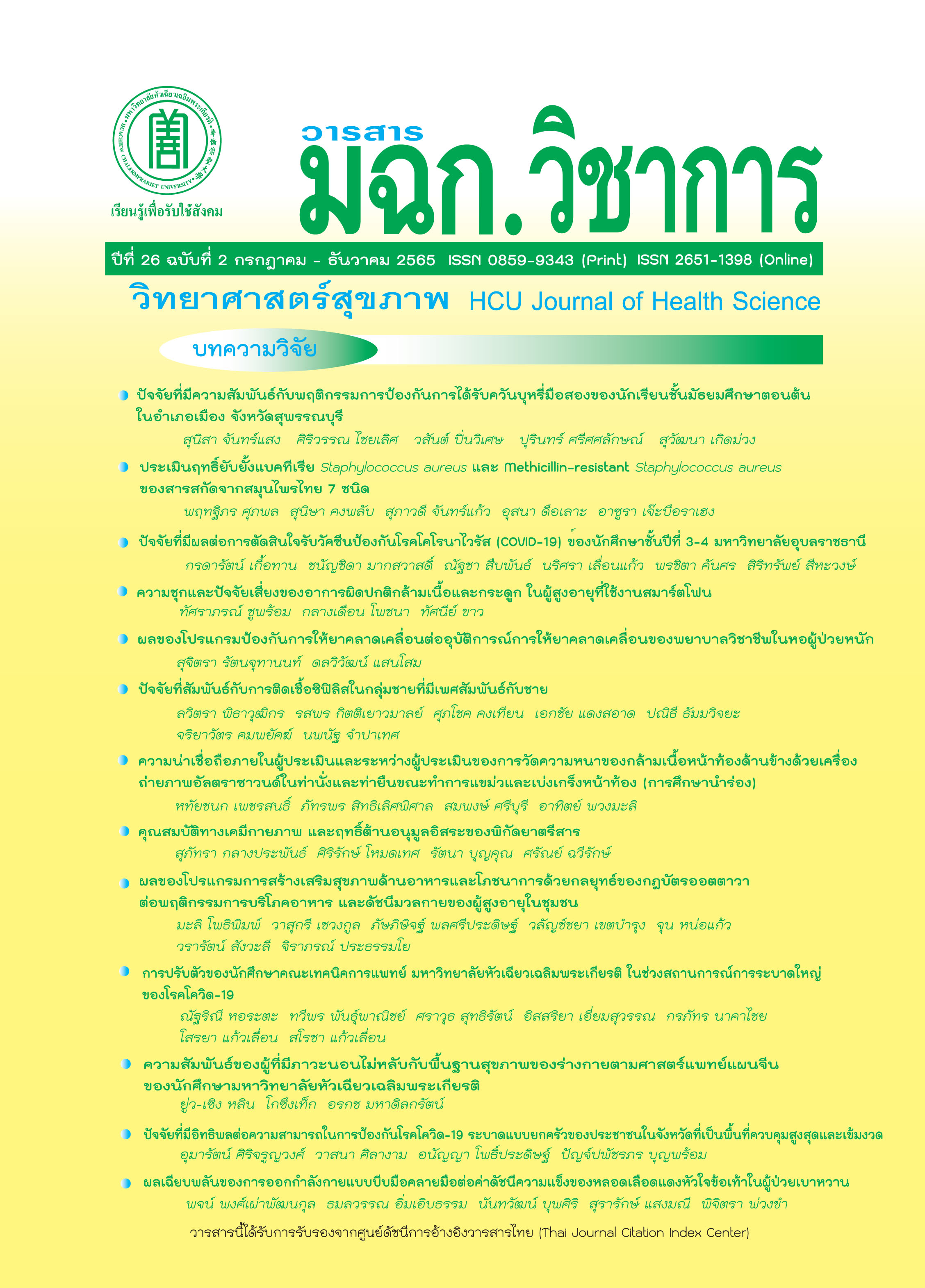Prevalence and Risk Factors of Musculoskeletal Disorder in Older People Smartphone Users
Keywords:
Prevalence, Musculoskeletal disorder, Older people, SmartphoneAbstract
Nowadays, older people take more interest in technology and often use smartphones in daily life. The use of smartphones for a long time may lead to Musculoskeletal Disorders (MSDs). Objective: The study was to investigate the prevalence and factors affecting MSDs in elderly smartphone users. Methods: Cross-sectional study was conducted using a structured questionnaire. The data included socio-demographic profile, smartphone usage, pattern, and prevalence of MSDs. Results: The study found that 90.72% of participants have spent time using a mobile device for greater than or equal to 2 hours a day. The overall prevalence of MSDs in elderly users was 100%. The most common areas were the neck 62.89%, upper back 53.61%, and shoulder 45.36%. Results overall revealed that time spent using a smartphone more than or equal to 120 minutes per day had a relationship with neck pain (OR=5.90, 95%CI: 1.12-31.02) and upper back pain (OR=9.40, 95%CI: 1.11-79.61) compared with using smartphone less 120 minutes per day. Furthermore, the use of smartphones with a big monitor size (more than 6 inches) had a relationship with arm muscle pain (OR=2.72, 95%CI: 1.14-6.47) and wrist pain (OR=2.96, 95%CI: 1.16-7.52) compared with the use of smartphones with a small monitor size (less than 6 inches). Conclusion: MSDs are common health problems in the elderly population. The results of this study revealed that musculoskeletal diseases are significantly high in elderly people with smartphone use. These findings should be suggested for reducing the risk of musculoskeletal disorders and preventive programs are also highly recommended to protect those vulnerable groups.
Downloads
References
Kuljitjuerwong S. Social media trap the role of communicating technology in digital Era. CUTJ. 2013;19(2):268–79.
We Are Social. Digital 2022 Thailand (February 2022) [Internet]. UpToDate; 2022 cited 2022 Aug 23]. Available from: https://www.slideshare.net/DataReportal/digital-2022-thailand-february-2022-v01
Prasertsuk J. Digital literacy and the aging society [Internet]. Digital Economy Promotion Agency (Depa). [cited 2021 Nov 23]. Available from: https://www.depa.or.th/th/article-view/digital-literacy
European Commision. Undesa-United nations department of economic and social affairs [Internet]. Knowledge for policy-European Commission [Internet]. ค.ศ. [cited 2020 Jul 2]. Available from: https://ec.europa.eu/knowledge4policy/organisation/undesa-united-nations-department-economic-social-affairs_en.html
Department of Older Persons (DOP). The current aging society and economy in Thailand [Internet]. UpToDate 2022 [cited 2022 Aug 23]. Available from: https://www.dop.go.th/th/know/side/1/1/1159
The National Statistical Office. Statistical Office Revealing the results of a survey on the use of information and communication technology in the household [Internet]. ค.ศ. [cited 2020 Mar 18]. Available from: http://www.nso.go.th/sites/2014/Pages/News/2561/N26-10-61
Suwancharoen S, Thamma-in S, Kerdmuang S, Pinitchan O, Chumchai P. Behaviors and effects of smartphone usage among high school students, Nonthaburi province. NJPH 2019;29(3):107–17.
Rammayan T, Boonyarit P. Prevalence of musculoskeletal symptoms at upper body parts due to smartphone using among lower secondary school students. Srinagarind Med J 2016; 31(6):392–9.
Sungkhapong A, Pochana K. Skeleton system. Ergonomics risk assessment. 1st. Songkhla: Educational Technology Faculty of Engineering, Prince of Songkhla University; 2013. pp.19-67.
Tapanya W, Puntumetakul R. Prevalence and risk factors of musculoskeletal disorders in smartphone users. Thai J Phys Ther 2019;41(3):148–63.
Silanoi L. How to use the appropriate statistical formulas for determining the sample size for quantitative research designs in the humanities and social science study. RDIBRU 2017; 12(2):50–61.
Berolo S, Wells RP, Amick BC. Musculoskeletal symptoms among mobile hand-held device users and their relationship to device use: A preliminary study in a Canadian university population. Applied Ergonomics 2011;42(2):371–8.
Intolo P. Comparison of muscular pain during smartphone use among three age groups: elementary school student, high school student and office worker. JHSR 2018;12(2):328-41.
Khruakhorn S. Prevalence and associated risk factors of thumb pain from using smartphone in secondary school students at Klongluang, Pathumthani. TMJ 2017;17:18–26.
Gold JE, Driban JB, Thomas N, Chakravarty T, Channell V, Komaroff E. Postures, typing strategies, and gender differences in mobile device usage: An observational study. Applied Ergonomics 2012;43(2):408–12.
Kim H-J, Kim J-S. The relationship between smartphone use and subjective musculoskeletal symptoms and university students. J Phys Ther Sci 2015;27(3):575–9.
Stalin P, Abraham SB, Kanimozhy K, Prasad RV, Singh Z, Purty AJ. Mobile Phone Usage and its Health Effects Among Adults in a Semi-Urban Area of Southern India. J Clin Diagn Res 2016; 10(1):14–6.
Namwongsa S, Puntumetakul R, Neubert MS, Boucaut R. Factors associated with neck disorders among university student smartphone users. Work 2018;61(3):367–78.
Namwongsa S, Puntumetakul R, Neubert MS, Boucaut R. Effect of neck flexion angles on neck muscle activity among smartphone users with and without neck pain. Ergonomics 2019; 62(12):1524–33.
Zhi shan, Deng G, Li J, Li Y, Zhao Q, Zhang Y. Correlational analysis of neck/shoulder pain and low back pain with the use of digital products, physical activity and psychological status among adolescents in Shanghai. PLOS ONE 2013;8(10):1-9.
Sea-jern NN, Pochana K, Sungkhapong A. The prevalence and personal factors related to musculoskeletal disorders in occupational van drivers: a case study of public transport center in Hatyai, Songkhla. Asia Pac J Sci Technol 2014;19(1):107-18.
Downloads
Published
How to Cite
Issue
Section
License
Copyright (c) 2022 HCU Journal

This work is licensed under a Creative Commons Attribution-NonCommercial-NoDerivatives 4.0 International License.
บทความที่ได้รับการตีพิมพ์เป็นลิขสิทธิ์ของวารสารวิทยาศาสตร์สุขภาพและสุขภาวะ
ข้อความที่ปรากฏในบทความแต่ละเรื่องในวารสารวิชาการเล่มนี้เป็นความคิดเห็นส่วนตัวของผู้เขียนแต่ละท่านไม่เกี่ยวข้องกับมหาวิทยาลัยหัวเฉียวเฉลิมพระเกียรติ และคณาจารย์ท่านอื่นๆในมหาวิทยาลัยฯ แต่อย่างใด ความรับผิดชอบองค์ประกอบทั้งหมดของบทความแต่ละเรื่องเป็นของผู้เขียนแต่ละท่าน หากมีความผิดพลาดใดๆ ผู้เขียนแต่ละท่านจะรับผิดชอบบทความของตนเองแต่ผู้เดียว




